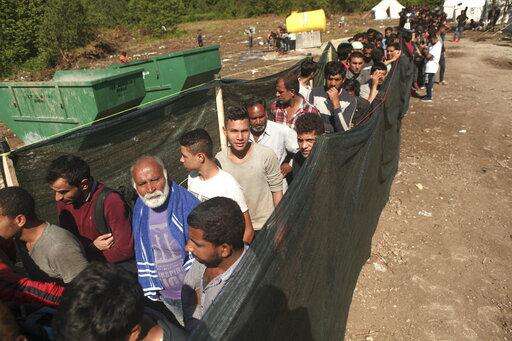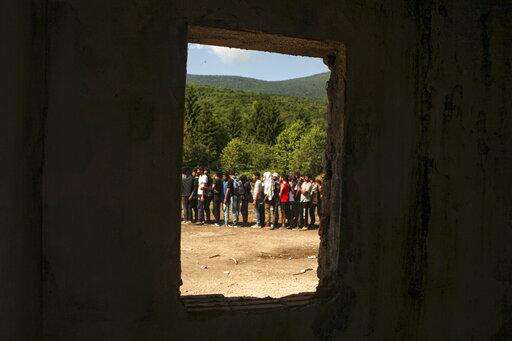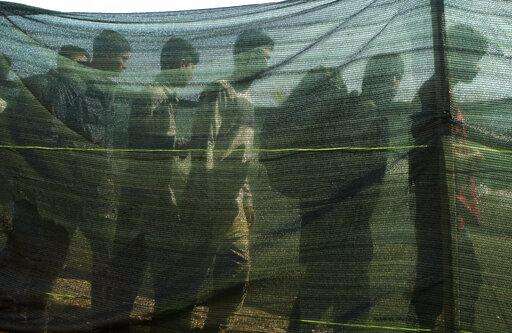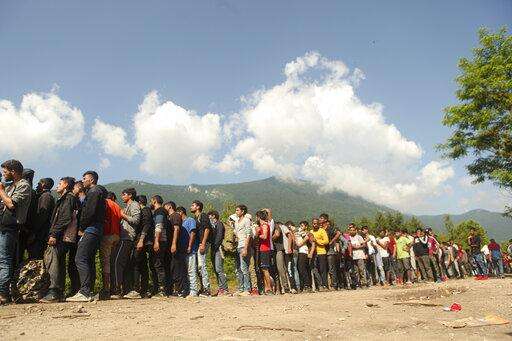In this photo taken on Wednesday, June 19, 2019, migrants wait in line to receive supplies from the Red Cross at the Vucijak camp outside Bihac, Bosnia. Still deeply scarred by a brutal inter-ethnic war in the 1990s, Bosnia has become the chief bottleneck in the main land route for thousands of migrants seeking a better life in Europe. According to Bosnian government statistics, 34,000 newcomers crossed into the country since the beginning of 2018, including 9,000 who arrived in the first five months of this year. (AP Photo/Almir Alic)
The Associated Press
SARAJEVO, Bosnia-Herzegovina (AP) - A covered-up landfill in a mine-infested part of a dysfunctional Balkan state whose own people are emigrating in droves might not seem ideal for a refugee camp.
But local authorities in Bihac, a Bosnian city of 50,000, had little choice.
Still deeply scarred by a brutal inter-ethnic war in the 1990s, Bosnia has become the chief bottleneck in the main land route for thousands of migrants seeking a better life in Europe.
Until the camp's opening last week at Vucjak, 8 kilometers (5 miles) from the border with European Union-member Croatia, thousands of migrants - mostly single men - were sleeping rough in Bihac and other cities in Bosnia's northwestern Krajina region.
Vucjak now provides 1,000 of them with tents and Red Cross meals. But few want to stay in Bosnia, and the nearby Croatian border looms inviting despite drastically-increased security with Croatian police allegedly beating and robbing migrants before pushing them back into Bosnia.
"We all want to pass to the dream, (to) united Europe. For freedom and good life," said camp resident Ramadan from Egypt, who reached Bosnia five months ago.
"But I do not think (it will happen)," added Ramadan, who only gave his first name for fear of repercussions to his family in Egypt.
Non EU-member Bosnia, with its turbulent past and poor resources, was initially shunned by migrants. But after a series of Balkan border closures it's now their last practicable, albeit illegal, jumping-off point for the continent's prosperous heartland.
About 26,000 people last year and 9,000 this year, chiefly from Pakistan and Bangladesh, entered the country of 3.5 million, mostly from Serbia after a trek through Greece, North Macedonia and Montenegro.
Most continued clandestinely over the 1,000-kilometer (620-mile), mountainous border into Croatia. Some 10,000 remain, chiefly in the Krajina area that has EU-funded camps for families which can hold 3,500.
Fewer than 200 requested asylum in Bosnia, which is ill-equipped to help them.
More than two decades after the 1992-95 war forced 2.2 million people to flee their homes, 100,000 Bosnians remain internally displaced. About 30,000 have left this year alone to work abroad.
The economy is weak, unemployment high, and simmering ethnic tensions make the government structure unwieldy and unable to address the inflows from Serbia or the alleged Croatian pushbacks.
Krajina has borne the brunt of immigration. Their own experiences of strife and expatriation led the people of Bihac to initially welcome newcomers. But as numbers increased, patience diminished.
"The international community and our national government imposed a burden we cannot carry," Bihac resident Sulejman Midzic told The Associated Press. "Now they are accusing us of being inhumane, but how we can be humane when we have nothing to give?"
Human rights organizations accuse Croatia's police of brutality to migrants and illegal pushbacks - which Croatia denies.
Bihac mayor Suhret Fazlic rejects those denials.
"Croatia treated us unfairly from day one ... they've been pushing migrants back to Bihac, including from deep within (Croatian) territory," even some returned to Croatia from neighboring Slovenia, he told the AP.
"Armed Croatian police are entering deep into (Bosnian) territory to deliver those suffering, hungry, thirsty, exhausted and sick people ... and we've been taking care of them for over a year," he added.
Last week, United Nations officials condemned the Vucjak camp as unsuitable for human habitation, highlighting the risk from the minefields and warning of potential explosions due to the possible presence of underground gas formed by decomposing garbage from the landfill.
The UN urged Bosnian officials to return migrants to Bihac.
In this photo taken on Wednesday, June 19, 2019, migrants wait in line to receive supplies from the Red Cross at the Vucijak camp outside Bihac, Bosnia. Still deeply scarred by a brutal inter-ethnic war in the 1990s, Bosnia has become the chief bottleneck in the main land route for thousands of migrants seeking a better life in Europe. According to Bosnian government statistics, 34,000 newcomers crossed into the country since the beginning of 2018, including 9,000 who arrived in the first five months of this year. (AP Photo/Almir Alic)
The Associated Press

In this photo taken on Wednesday, June 19, 2019, Ramadan, a migrant from Egypt, who did not want his family name fearing for the safety of his family, pauses during an interview with the Associated Press at the Vucijak camp outside Bihac, Bosnia. Still deeply scarred by a brutal inter-ethnic war in the 1990s, Bosnia has become the chief bottleneck in the main land route for thousands of migrants seeking a better life in Europe. According to Bosnian government statistics, 34,000 newcomers crossed into the country since the beginning of 2018, including 9,000 who arrived in the first five months of this year. (AP Photo/Almir Alic)
The Associated Press

In this photo taken on Wednesday, June 19, 2019, migrants wait in line to receive supplies from the Red Cross at the Vucijak camp outside Bihac, Bosnia. Still deeply scarred by a brutal inter-ethnic war in the 1990s, Bosnia has become the chief bottleneck in the main land route for thousands of migrants seeking a better life in Europe. According to Bosnian government statistics, 34,000 newcomers crossed into the country since the beginning of 2018, including 9,000 who arrived in the first five months of this year. (AP Photo/Almir Alic)
The Associated Press

In this photo taken on Wednesday, June 19, 2019, migrants and refugees wait in line to receive supplies from the Red Cross at the Vucijak camp outside Bihac, Bosnia. Still deeply scarred by a brutal inter-ethnic war in the 1990s, Bosnia has become the chief bottleneck in the main land route for thousands of migrants seeking a better life in Europe. According to Bosnian government statistics, 34,000 newcomers crossed into the country since the beginning of 2018, including 9,000 who arrived in the first five months of this year. (AP Photo/Almir Alic)
The Associated Press

In this photo taken on Wednesday, June 19, 2019, migrants and refugees wait in line to receive supplies from the Red Cross at the Vucijak camp outside Bihac, Bosnia. Still deeply scarred by a brutal inter-ethnic war in the 1990s, Bosnia has become the chief bottleneck in the main land route for thousands of migrants seeking a better life in Europe. According to Bosnian government statistics, 34,000 newcomers crossed into the country since the beginning of 2018, including 9,000 who arrived in the first five months of this year. (AP Photo/Almir Alic)
The Associated Press

In this photo taken on Wednesday, June 19, 2019, migrants and refugees wait in line to receive supplies from the Red Cross at the Vucijak camp outside Bihac, Bosnia. Still deeply scarred by a brutal inter-ethnic war in the 1990s, Bosnia has become the chief bottleneck in the main land route for thousands of migrants seeking a better life in Europe. According to Bosnian government statistics, 34,000 newcomers crossed into the country since the beginning of 2018, including 9,000 who arrived in the first five months of this year. (AP Photo/Almir Alic)
The Associated Press

In this photo taken on Wednesday, June 19, 2019, migrants and refugees wait in line to receive supplies from the Red Cross at the Vucijak camp outside Bihac, Bosnia. Still deeply scarred by a brutal inter-ethnic war in the 1990s, Bosnia has become the chief bottleneck in the main land route for thousands of migrants seeking a better life in Europe. According to Bosnian government statistics, 34,000 newcomers crossed into the country since the beginning of 2018, including 9,000 who arrived in the first five months of this year. (AP Photo/Almir Alic)
The Associated Press

In this photo taken on Wednesday, June 19, 2019, migrants and refugees wait in line to receive supplies from the Red Cross at the Vucijak camp outside Bihac, Bosnia. Still deeply scarred by a brutal inter-ethnic war in the 1990s, Bosnia has become the chief bottleneck in the main land route for thousands of migrants seeking a better life in Europe. According to Bosnian government statistics, 34,000 newcomers crossed into the country since the beginning of 2018, including 9,000 who arrived in the first five months of this year. (AP Photo/Almir Alic)
The Associated Press